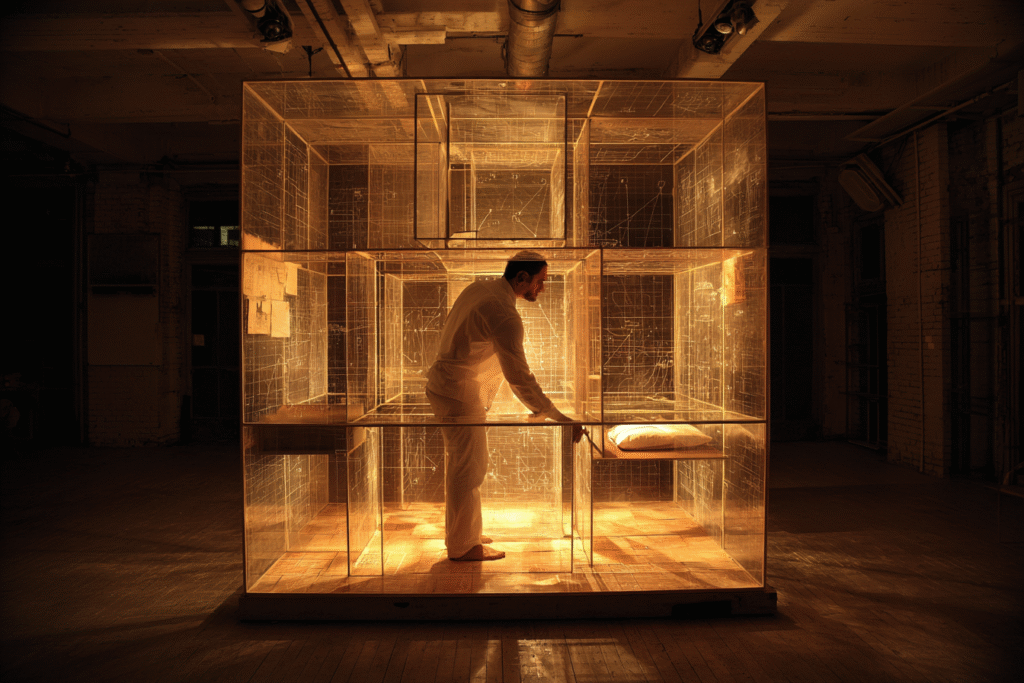Why do smart people make their worst health decisions when it matters most?
Note: This article is for educational and informational purposes only. See full disclaimer at the end.
I’ve seen this pattern play out in my own family—brilliant, capable people unable to translate intelligence into healthy living.
At a gathering last year, one of my relatives finally admitted: “I knew something was off for months. I could feel it, see the signs, but I just kept pushing through.”
What struck me wasn’t the confession—it was how familiar it sounded. Around the table, everyone nodded. We’d all done the same. We knew better. And yet we delayed.
This isn’t unique to my family. It’s a pattern I’ve observed repeatedly in high-achieving individuals: the same analytical capabilities that make them exceptional in their domains somehow fail them when it comes to health decisions.
Welcome to the Choice Paradox—the bizarre phenomenon where intelligence becomes a barrier to optimal health decisions rather than an advantage.
The Intelligence Trap
To understand how this paradox manifests, we need to examine the data on high-achieving populations and the specific ways intelligence can work against us.

The data on this phenomenon is striking.
Research shows that entrepreneurs are 2.5 times more likely to develop depression compared to other professionals [1], with 72% directly or indirectly affected by mental health issues [2]. Despite having access to more health information than any generation in history, 42% of business owners report experiencing burnout in the past month [3].
This isn’t about lack of information or willpower. The neurosurgeon who lives on energy drinks and takeout understands nutrition science. The behavioral economist who researches habit formation can’t maintain an exercise routine. The wellness influencer who preaches balance burns out from overwork.
These aren’t isolated cases—they represent a systematic failure where cognitive strengths become health weaknesses.
The transition from intellectual understanding to behavioral implementation creates a cognitive gap that intelligence alone cannot bridge.
But what exactly creates this gap? The answer lies in four specific cognitive patterns that turn our mental strengths into health vulnerabilities.
The Four Cognitive Barriers
Understanding these barriers is the first step toward overcoming them:
1. The Optimization Obsession
Intelligent people love optimization. We want the perfect diet, the most efficient workout, the ideal sleep protocol. This pursuit of perfection becomes paralyzing. Instead of starting with sustainable choices, we research endlessly for the optimal solution.
Research on perfectionism confirms this barrier. Studies show that perfectionism can significantly limit treatment effectiveness and behavior change [4], with perfectionists more likely to experience procrastination and treatment attrition [5] due to their tendency to avoid tasks unless they can be executed flawlessly.
The reality: A mediocre plan executed consistently beats a perfect plan that never gets implemented.
2. The Complexity Addiction
Smart people are comfortable with complexity. We can hold multiple variables in mind, understand nuanced interactions, and appreciate sophisticated systems. But health thrives on simplicity. The most effective health interventions are often embarrassingly basic: move regularly, eat real food, sleep adequately, manage stress.
Our brains reject simple solutions as too obvious to be effective, leading us to seek complicated approaches that are harder to maintain. This cognitive bias toward complexity over simplicity creates what researchers call “analysis paralysis” in health decision-making.

3. The Future Discounting Error
Intelligent people excel at long-term thinking in their professional lives, yet systematically undervalue future health outcomes. We make career investments that pay off decades later while ignoring health investments with similar timelines.
The immediate rewards of work—recognition, money, status—are tangible and social. The rewards of health choices—feeling better, disease prevention, longevity—are largely invisible and solitary. Neuroscience research reveals that executive function becomes depleted throughout the day [6], explaining why brilliant people make excellent strategic decisions at 10 AM and terrible health choices at 8 PM.
4. The Control Illusion
High achievers are used to controlling outcomes through effort and intelligence. When health doesn’t respond immediately to our interventions, we assume the approach is wrong rather than giving it time to work. This leads to constant strategy switching, preventing any single approach from demonstrating effectiveness.
Decision fatigue research shows that after making numerous decisions, the quality of subsequent choices significantly declines [7]. For entrepreneurs making hundreds of micro-decisions daily, health choices often occur when cognitive resources are most depleted.
These cognitive barriers don’t exist in isolation—they compound each other and are magnified in high-pressure environments. To see how severe this problem has become, we need to look at the broader epidemic affecting our most driven individuals.
The Entrepreneurial Burnout Epidemic
The statistics paint a sobering picture of how the Choice Paradox manifests in high-achieving populations.
The numbers are stark: one in five entrepreneurs work 60+ hours weekly [8], while 30% regularly experience burnout [9]. Only a third take proper vacations [10], and nearly two-thirds suffer sleep issues from business stress [11]. Perhaps most telling, 80% report feeling overworked [12].

While these statistics focus on entrepreneurs, the pattern extends to anyone whose success depends on sustained cognitive performance—executives, professionals, academics, and high-achievers across all fields who face similar cognitive demands.
Elon Musk has publicly discussed working 120-hour weeks and sleeping on the Tesla factory floor. Arianna Huffington collapsed from exhaustion and broke her cheekbone, leading to her advocacy for sleep and well-being.
These aren’t isolated incidents—they represent the logical endpoint of prioritizing cognitive performance over physical maintenance.
Yet even when we recognize these patterns, breaking free proves remarkably difficult. This leads us to perhaps the most frustrating aspect of the Choice Paradox.
The Meta-Cognitive Trap
The cruelest irony of the Choice Paradox is that intelligent people can see it happening to themselves. But understanding the trap doesn’t automatically free you from it.
Knowledge without implementation becomes sophisticated procrastination.
We feel productive while avoiding the discomfort of change.
This creates a secondary layer of frustration. Not only are we making poor health choices, but we’re acutely aware of why we’re making them, which compounds the sense of being trapped in patterns we intellectually know are counterproductive.
But why isn’t awareness enough? The answer lies in our brain’s biological limitations during decision-making.
The Neuroscience of Smart Self-Sabotage
The biological reality behind the Choice Paradox is both fascinating and sobering:
Recent research reveals why intelligence works against health decisions. The prefrontal cortex—responsible for executive function and logical analysis—is depleted by decision fatigue and stress [13]. Intelligent people often exhaust this cognitive resource through work, leaving minimal capacity for health choices.
Studies using functional MRI show that during decision fatigue, brain regions involved in reasoning and decision-making become less active [14]. This explains why brilliant strategists make poor evening food choices and why successful executives skip workouts they planned in the morning.
Research on judicial decision-making demonstrates this pattern: favorable rulings drop from 65% to nearly zero within decision sessions, returning to 65% after breaks [15]. The same cognitive depletion affects health choices throughout our day.
Now that we understand the problem and its underlying mechanisms, the question becomes: how do we escape this trap?
The solution requires working with our psychology, not against it. This is where most approaches fail—they add complexity when simplicity is needed.

Break the Paradox, Keep It SIMPLE
The key is redirecting our intelligence toward simplicity rather than complexity. Traditional approaches fail because they add more complexity to already overwhelmed cognitive systems.
The solution must be counterintuitive.
After observing these patterns across numerous high-achievers, I’ve developed a framework, first for myself then for others, specifically designed to help intelligent people escape their cognitive traps:
S – Start Stupidly Simple
This directly counters the Optimization Obsession by removing the need for perfect planning.
Begin with interventions so basic they feel almost insulting to your intelligence:
- 10 minutes of walking daily
- One vegetable at every meal
- 8 hours in bed (not perfect sleep, just time allocation)
- 5 minutes of deep breathing
The goal isn’t optimization—it’s momentum. Research on identity-based habits shows that small, consistent actions gradually reshape self-perception [16], creating sustainable behavior change through identity reinforcement rather than willpower.
I – Ignore the Optimization Urge
This breaks the Complexity Addiction cycle that keeps us researching instead of acting.
Take a deliberate pause on research and refinement for the first 30 days. No reading new studies, trying new protocols, or adjusting your approach.
Studies on perfectionism demonstrate that those who delay action seeking perfect plans are significantly less likely to achieve behavior change [17].
M – Measure Leading Indicators, Not Outcomes
Track inputs (did you do the thing?) rather than outputs (did it work?). Count workouts completed, not pounds lost. Monitor sleep schedule adherence, not energy levels.
This maintains motivation during the lag time before results appear.

P – Protect Through Systems, Not Willpower
This addresses the Control Illusion by creating automatic responses that don’t require constant decision-making.
Design your environment to make good choices automatic and bad choices inconvenient. Research on implementation intentions shows that specific if-then planning significantly improves behavior adherence [18].
Remove decision-making burden from your conscious mind.
L – Link to Identity, Not Goals
Frame health choices as expressions of who you are, not achievements to unlock. “I am someone who moves my body daily” rather than “I want to lose 20 pounds.”
Identity-based changes are more sustainable than outcome-based goals [19], because they reaffirm who you are every time you act on them.
E – Embrace Good Enough
Accept that B+ consistency beats A+ perfection. A simple routine maintained for years creates more value than a sophisticated protocol abandoned after weeks. Studies show that perfectionism often impairs rather than improves performance [20] by creating unrealistic standards that lead to avoidance.
Your analytical mind will resist this approach—it seems too basic, too obvious. You’ll want to add complexity, find the ‘real’ solution, or research better alternatives. This resistance is exactly the problem we’re solving.
The most intelligent people often struggle most with simple solutions because simplicity feels insufficient for complex problems. But that’s the trap—health problems aren’t complex problems requiring complex solutions. They’re simple problems requiring consistent execution.
Think of SIMPLE like the emergency brake for your runaway cognition. It doesn’t fight your intelligence. It redirects it—toward consistency instead of complexity.
Understanding this framework is one thing—but implementing it requires recognizing the broader implications of our choices.
The Compound Effect of Poor Choices
The stakes of the Choice Paradox extend far beyond immediate health outcomes:
The Choice Paradox has compound consequences beyond physical health. Poor health decisions impact cognitive performance, emotional regulation, and decision-making capacity, creating a downward spiral where declining health makes good choices even harder.
Conversely, breaking the paradox creates an upward spiral. Small, consistent health improvements enhance cognitive function [21], making better choices easier over time. The investment compounds both biologically and psychologically.
Research consistently shows that physical exercise improves cognitive functions, particularly attention, memory, and executive functions [22]. Aerobic fitness spares age-related loss of brain tissue and enhances functional aspects of higher-order regions involved in cognitive control [23]. This creates a positive feedback loop where good health choices literally improve our capacity to make better decisions.
This understanding transforms how we approach the challenge—it’s not just about health, it’s about optimizing the very intelligence we rely on for success.

From Analysis to Action: A Personal Reflection
Real change begins when we stop intellectualizing and start implementing:
Watching my family members finally acknowledge their health avoidance patterns was a wake-up call. The relative who’d been ignoring symptoms for months has since implemented basic changes—starting with a 15-minute morning walk and protecting 7.5 hours for sleep. Six months later, they report feeling more energetic and making better decisions throughout the day.
The path out of the Choice Paradox isn’t through more analysis—it’s through strategic simplification.
We must deliberately constrain options, reduce decision complexity, and design systems that work with our psychology rather than against it. This requires treating health not as an optimization problem to solve, but as a practice to maintain. Not as a destination to reach, but as a way of being to embody.
Ready to take action? Here’s how to start immediately.
Your Implementation Strategy
Don’t wait for more information or perfect conditions—begin today:
Starting tomorrow, apply the SIMPLE framework:
- Choose one stupidly simple health behavior (5-minute walk, one glass of water upon waking, 7-hour sleep target)
- Commit to 30 days without modification (no optimization, no research, no adjustments)
- Track only compliance (did you do it? yes/no)
- Design environmental support (lay out walking shoes, fill water bottle the night before)
- Connect to identity (“I am someone who…”)
The goal isn’t perfect health—it’s escaping the paralysis of perfect analysis.

Your Intelligence, Redirected
The Choice Paradox doesn’t diminish your intelligence—it reveals how to use it more effectively:
Your intelligence is a tremendous asset for long-term health, but only when properly directed. The same cognitive horsepower that creates complexity can design simplicity. The same analytical skills that seek optimization can recognize when optimization is the enemy of action.
The Choice Paradox dissolves when we stop trying to think our way to better health and start designing our way there—through systems, not willpower.
Intelligence isn’t the enemy. It’s just been aimed in the wrong direction.
Like a laser with no target, it cuts chaotically without direction. But when you give it structure—a clear focal point—that same energy becomes precise, purposeful, healing. Instead of burning through your willpower, it builds the very systems that support your success.
Start simple. Stay consistent. Let your brilliance serve your biology.
Tomorrow, we’ll explore how to build comprehensive health systems that work with your intelligence rather than against it, creating sustainable transformation through systematic implementation.
See you in the next insight.
Comprehensive Medical Disclaimer: The insights, frameworks, and recommendations shared in this article are for educational and informational purposes only. They represent a synthesis of research, technology applications, and personal optimization strategies, not medical advice. Individual health needs vary significantly, and what works for one person may not be appropriate for another. Always consult with qualified healthcare professionals before making any significant changes to your lifestyle, nutrition, exercise routine, supplement regimen, or medical treatments. This content does not replace professional medical diagnosis, treatment, or care. If you have specific health concerns or conditions, seek guidance from licensed healthcare practitioners familiar with your individual circumstances.
References
Carmine Mastropierro. “13+ Fascinating Entrepreneur Burnout Statistics.” 2023. https://carminemastropierro.com/entrepreneur-burnout-statistics/
LifehackMethod. “Entrepreneur Mental Health and Burnout Statistics.” 2024. https://lifehackmethod.com/blog/entrepreneur-mental-health-statistics/
Founder Reports. “17 Mental Health Statistics for Entrepreneurs (2024).” 2025. https://founderreports.com/entrepreneur-mental-health-statistics/
Shafran, R., et al. “Beyond perfect? A case illustration of working with perfectionism using cognitive behavior therapy.” PMC. https://pmc.ncbi.nlm.nih.gov/articles/PMC7689738/
Wikipedia. “Perfectionism (psychology)” – Research on perfectionism treatment effectiveness. https://en.wikipedia.org/wiki/Perfectionism_(psychology)
Pignatiello, G.A., et al. “Decision fatigue: A conceptual analysis.” Journal of Health Psychology. 2020. https://journals.sagepub.com/doi/abs/10.1177/1359105318763510
Hirshleifer, D., et al. “Decision fatigue and heuristic analyst forecasts.” Journal of Financial Economics. 2019. https://www.sciencedirect.com/science/article/abs/pii/S0304405X19300054
ZipDo. “Essential Entrepreneur Burnout Statistics In 2024.” https://zipdo.co/statistics/entrepreneur-burnout/
GitNux. “Entrepreneur Burnout Statistics.” https://gitnux.org/entrepreneur-burnout-statistics/
Sana Ross. “The Impact of Burnout on Entrepreneurial Risk-Taking.” 2025. https://www.sanaross.com/the-neuroscience-of-achieving-more/the-impact-of-burnout-on-entrepreneurial-risk-taking
Founder Reports. “17 Mental Health Statistics for Entrepreneurs (2024).” 2025. https://founderreports.com/entrepreneur-mental-health-statistics/
GitNux. “Entrepreneur Burnout Statistics.” https://gitnux.org/entrepreneur-burnout-statistics/
The Decision Lab. “Decision Fatigue.” https://thedecisionlab.com/biases/decision-fatigue
Scientific Reports. “Effects of mental fatigue on risk preference and feedback processing in risk decision-making.” https://www.nature.com/articles/s41598-022-14682-0
Danziger, S., Levav, J., & Avnaim-Pesso, L. “Extraneous factors in judicial decisions.” Proceedings of the National Academy of Sciences. 2011. https://www.pnas.org/doi/10.1073/pnas.1018033108
Clear, James. “Identity-Based Habits: How to Actually Stick to Your Goals This Year.” https://jamesclear.com/identity-based-habits
Limburg, K., et al. “Perfectionism and mental health problems: Limitations and directions for future research.” PMC. https://www.ncbi.nlm.nih.gov/pmc/articles/PMC9125265/
Gollwitzer, P.M. & Sheeran, P. “Implementation intentions and goal achievement: A meta-analysis of effects and processes.” Taylor & Francis Online. https://www.tandfonline.com/doi/full/10.1080/10463283.2020.1808936
Clear, James. “How to Change Your Beliefs and Stick to Your Goals for Good.” https://jamesclear.com/identity-votes
Shafran, R., et al. “Beyond perfect? A case illustration of working with perfectionism using cognitive behavior therapy.” PMC. https://pmc.ncbi.nlm.nih.gov/articles/PMC7689738/
Mandolesi, L., et al. “Effects of Physical Exercise on Cognitive Functioning and Wellbeing: Biological and Psychological Benefits.” PMC. https://pmc.ncbi.nlm.nih.gov/articles/PMC5934999/
Mekari, S., et al. “Move Your Body, Boost Your Brain: The Positive Impact of Physical Activity on Cognition across All Age Groups.” MDPI. https://www.mdpi.com/2227-9059/11/6/1765
Gomez-Pinilla, F. & Hillman, C. “The Influence of Exercise on Cognitive Abilities.” PMC. https://pmc.ncbi.nlm.nih.gov/articles/PMC3951958/


